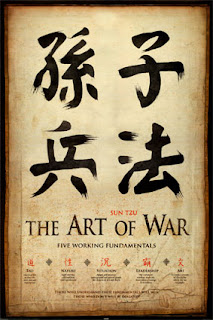the book itself consists of 13 points with their correspondent subdivisions. each point treats a different topic regarding warfare and advices how a good general should act in front of certain situations. though they are really explicative and sometimes didactic, most of the points require the general's previous experience in some kind of confrontation. When one reads the book, you realize that many statements repeat throughout the points, it gives you the sensation that indeed it is some kind of compilation of manuscripts under the one name of Sun Tzu.
But why call it an art? probably people would tend to think when first encounter the book that, it would probably describe how to fight, how to kill, and the most effective ways of inflicting pain on the enemy. It is not so, "The Art of War" deals with how a general should lead his army as to win a war without fighting it, saying that war is based on "deception". now THAT is what I might consider "art". The advices given are not meant to foster brutality but rather prudence, caution and diplomacy. It does not say either how to train your troops, the best physical training, or the sort of weapons, the best armour, etc. It "teaches" the general to identify hints, signs from the enemy and therefore be prepare for what might come. Sun Tzu says that "plans should be modified according to favourable circumstances."
The 13 point in the book are:
- Laying Plans: Sun Tsu says that the art of war is governed by 5 important factors
- The moral Law
- Heaven
- Earth
- The commander
- Method and Discipline
- Waging War: In the book is described how expensive is to raised an army of thousand men. Also that no country benefits from prolonged wars.
- Attack by Stratagem: This makes reference to attacking by knowing very well the potential of the other army and thus gives five essentials for victory.
- He will win who knows when to fight and when not to.
- He will win who knows how to handle both superior and inferior forces
- He will win whose army is animated by the same spirit throughout all its ranks
- He will win, prepared himself, waits to take the enemy unprepared.
- He will win who has military capacity and it's not interfered by the sovereign.
- Tactical Dispositions: Sun Tzu says: "To secure ourselves against defeat lies in our own hands, but the opportunity of defeating the enemy is provided by the enemy himself." basically it means to attack or to defend with full knowledge of the enemy's capacity.
- Energy: Energy refers as to how a good general should control an army, where to attack and focus the troops.
- Weak points and Strong: I will present just two examples which are self-explanatory.
- Sun Tzu said: Whoever is first in the field and awaits the coming of the enemy, will be fresh for the fight; whoever is second in the field and has to hasten to battle will arrive exhausted.
- Therefore the clever combatant imposes his will on the enemy, but does not allow the enemy’s will to be imposed on him.
- Maneuvering: Sun Tzu describes the relations with the neighbouring powers, and when to attack an enemy army.
- Variations in Tactics: Sun Tzu says that there are just two: the indirect and the direct. The combination of both creates an endless possibility of confronting an enemy.
- The Army on the March: In this passage is described the different difficulties that moving an army implies, and how to do it as best as possible.
- Terrain: A description of the different terrains either on the battlefield or during the march that the army may encounter, and how to maneuver.
- The Nine Situations: In this part the author describes the different grounds on the battlefield and the way to confront an enemy according to the physical conditions of the ground.
- The Attack by Fire: how to use fire, when and with what purpose.
- The use of Spies: As all warfare is based on deception, it is imperative to know what the enemy is planning.


No hay comentarios:
Publicar un comentario